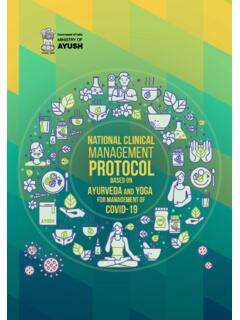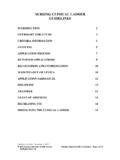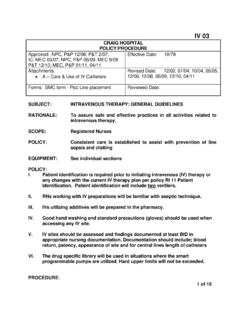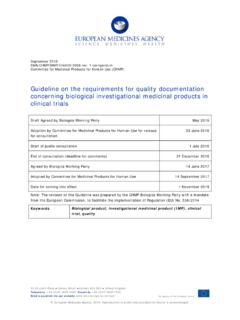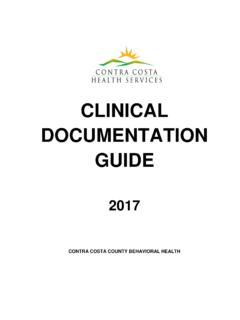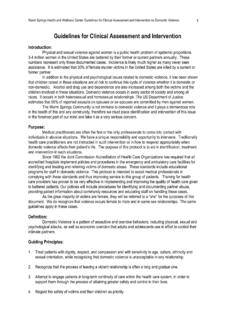Transcription of GENERAL GUIDELINES FOR CLINICAL EVALUATION OF …
1 GUIDELINES SERIES-IIIGENERAL GUIDELINES FOR CLINICAL EVALUATION OF AYURVEDIC INTERVENTIONSCENTRAL COUNCIL FOR RESEARCH IN AYURVEDIC SCIENCES Ministry of AYUSH, Government of India New DelhiIllllllllllllllllllllllllllllllllll llllllllllllllllllllllllllllllllllllllll llllllllllllllllllllllllllllllllllllllll lllllllllllllllllllllllllllllllGENERAL GUIDELINES FOR CLINICAL EVALUATION OF AYURVEDIC INTERVENTIONSV olume - IIICENTRAL COUNCIL FOR RESEARCH IN AYURVEDIC SCIENCES Ministry of AYUSH, Government of India New Delhiiiiiiiiiiiiiiiiiiiiiiiiiiiiiiiiiiii iiiiiiiiiiiiiiiiiiiiiiiiiiiiiiiiiiiiiiii iiiiiiiiiiiiiiiiiiiiiiiiiiiiiiiiiiiiiiii iiiiiiiiiiiiiiiiiiiiiiiiiiiiiiiIllllllll llllllllllllllllllllllllllllllllllllllll llllllllllllllllllllllllllllllllllllllll llllllllllllllllllllllllllllllllllllllll lllllllllllllllll Central Council for Research in Ayurvedic Sciences Ministry of AYUSH, Government of India, New Delhi - 110058 First Edition - 2018 Publisher: Central Council for Research in Ayurvedic Sciences, Ministry of AYUSH, Government of India, New Delhi, J.
2 L. N. B. C. A. H. Anusandhan Bhavan, 61-65, Institutional Area, Opp. D-Block, Janakpuri, New Delhi - 110 058, E-mail: Website : : All possible efforts have been made to ensure the correctness of the contents. However Central Council for Research in Ayurvedic Sciences, Ministry of AYUSH, shall not be accountable for any inadvertent error in the content. Corrective measures shall be taken up once such errors are brought to : 978-93-83864-22-5 Other Related GUIDELINES :Volume-I: GENERAL GUIDELINES for Drug Development of Ayurvedic Formulations Volume - II: GENERAL GUIDELINES for Safety/Toxicity EVALUATION of Ayurvedic FormulationsPrinted a t: JK Offset Graphics Pvt. Ltd., New Delhi-110020iiiiiiiiiiiiiiiiiiiiiiiiiiii iiiiiiiiiiiiiiiiiiiiiiiiiiiiiiiiiiiiiiii iiiiiiiiiiiiiiiiiiiiiiiiiiiiiiiiiiiiiiii iiiiiiiiiiiiiiiiiiiiiiiiiiiiiiiiiiiiiiIl llllllllllllllllllllllllllllllllllllllll llllllllllllllllllllllllllllllllllllllll llllllllllllllllllllllllllllllllllllllll llllllllllllllllllllllllPROLOGUER esearch and Development in the field of AYUSH system in different areas such as drug development including quality assurance, pre- CLINICAL safety EVALUATION and CLINICAL Research are being conducted at different levels such as Research Council under AYUSH, Academic institutions (both AYUSH and non AYUSH institutes such as Medical Colleges, Universities etc.)
3 , other Research organizations such as ICMR, CSIR etc. Further, research support is also being extended through grant under Extra Mural Research (EMR) vide Ministry of AYUSH, DST, DBT, ICMR etc. in the area o f traditional of research is being conducted at different levels as above in the field of AYUSH adopting different GUIDELINES , methods and protocols and ending up research outcomes with low or poor translational value. Only few of them have led to CLINICAL trial and marketing level. This may be attributed to lack of awareness regarding AYUSH strategies for R&D and provisions of Drug & Cosmetic Act related to spite of availability of several GUIDELINES such as GCP GUIDELINES for ASU drugs, ICMR GUIDELINES for Bio medical Research for Human Participants, GCP GUIDELINES published by CDSCO Ministry of Health and Family Welfare, WHO GUIDELINES for traditional medical research and GCP GUIDELINES for ASU drugs published by Ministry of AYUSH, there is no single comprehensive directive to conduct research in AYUSH sector is might be one among the major reasons that has led to Research and Development in AYUSH sector with diverse approaches with low translational view of this.
4 It becomes imperative to develop directives on research practices for various components o f AYUSH research sectors for uniform adoption across all stake holders such as research councils, academic institutes, funding agencies engaged in AYUSH this, efforts have been made by CCRAS and developed three comprehensive and concise GUIDELINES focusing on drug development (Standardization and quality assurance), safety and toxicity and CLINICAL EVALUATION for ready reference of stakeholders. These GUIDELINES encompassed with research practices may be suitably adopted and followed by investigators in the field of Ayurveda system such as Research organizations, academic institutions and Investigators seeking grant from schemes of different agencies funding for research on AYUSH system, would certainly help the investigators while designing and formulating the proposals and also planning academic industrial research in the field of AYUSH systems.
5 The users may refer other two documents for having an overall idea concerning drug development and R & D in this with obligation of an individual or organization to account for its activities, accept responsibility for them, and to disclose the results in a transparent relevant, the Act means Drugs & Cosmetics Act 1940 (23 of 1940) and the Rulesmade Drugreactions(ADR)All noxious and unintended responses to a medicinal product related to any dose used in human for the prophylaxis, diagnosis, or therapy of disease, or for the modifications o f physiological function. ADRs are classified into six types: dose-related (augmented), non-dose- related (Bizarre), dose-related and time-related (Chronic), time- related (delayed) withdrawal (end of use) and failure of therapy (failure). eventAny untoward medical occurrence in a participant or CLINICAL investigation participate administered an investigational product and which does not necessarily have a casual relationship with this treatment.
6 The adverse event can therefore be any unfavorable or unintended sign or experience associated with the use of the investigational product, whether or not related to the agree or approve after thoughtful consideration of an idea or suggestion. In these GUIDELINES it means agreement or approval mostly in children > 8 years of age, which has to be corroborated with informed consent of legally authorized representative (LAR). official record of the review decision along with comments and dated signature o f the systematic and independent examination of trial activities and documents to determine whether the review and approval activities were conducted and data were recorded and accurately reported according to the study protocol, SOPs, GCP, Declaration of Helsinki and applicable GUIDELINES and regulatory means the Biomedical and Health Research Authority established under an is the ability and capacity of a rational individual to make an independently informed decision to volunteer as a research drug Includes all medicines intended for internal or external use for or in the diagnosis, treatment, mitigation or prevention of disease or disorder in human beings or animals.
7 And manufactured exclusively in accordance with the formulae described in the authoritative texts of ayurvedic system of medicine and Ayurvedic pharmacopeia of India specified in the first schedule of the Drugs & cosmetics Act 1940, Rules, 1945. These are also called as classical drugs which are manufactured and named in accordance with the formulations described in the authoritative any existing/ new intervention with drug, therapeutic regimens (Panchakarma and lifestyle advocacy, etc.), or parasurgical (Agnikarma, leech application, Ksharasutra, etc.) or surgical procedure or device in to studies of the behaviour of individuals, or groups, or organizations or andHealthResearchIncludes basic, applied and operational research designed primarily to increase the scientific knowledge about diseases and conditions (physical or socio-behavioral), their detection, cause and strategies for health promotion or amelioration of disease and rehabilitation and includes CLINICAL / MaskingA method of control experimentation in which one or more parties involved are not informed of the treatment being given.
8 Single blind refers to the study subject(s) being unaware, while Double blind refers to the study subject(s) and/or investigators), monitor, data analyst(s) are being unaware of the treatment studies A blind or blinded study is an experiment in which information about the test is masked (kept) from the participant, to reduce or eliminate bias, until after a trial outcome is known. Double blinded means even the investigator does not know which is the test control studiesA study that compares participants who have a disease or outcome of interest (cases) with participants who do not have the diseases or outcome (controls), and looks back retrospectively to compare frequently the exposure to a risk factor is present in each group to determine the relationship between the risk factor and the report form (CRF)Case record form or case report form is printed, optical or electronic document designed to record all of the protocol required information to be reported to the sponsor on each trial seriesA case series (also known as a CLINICAL series)
9 Is a type of medical research that tracks participants with a known exposure, , participant who have received a similar treatment or examines their medical records for exposure and trials registry- India (CTRI)A CLINICAL trials registry is an official platform for registering a trial involving human participants in trialA CLINICAL trial is any systematic research / study that prospectively assign human participants or groups o f humans to one or more health- related intervention/s to EVALUATION the safety and of privacy of study subjects including their personal identity and all medical information, from individuals other than those prescribed in the Protocol. Confidentiality also covers the prevention of disclosure of sponsor s proprietary information to unauthorised A person legally qualified to be an investigator, to whom the Investigator delegates a part of his and SafetyMonitoringBoardThe Data and Safety Monitoring Board (DSMB) is a board, charged with monitoring the accumulating data from a pharmacotherapeuticclinical trial to detect and report early evidence of prespecified or unanticipated benefit or harm to trial participants that may be attributable to one of the treatments under EVALUATION .
10 The DSMB will conduct an independent, objective review of alllllllllllllllllllllllllllllllllllllll llllllllllllllllllllllllllllllllllllllll llllllllllllllllllllllllllllllllllllllll lllllllllllllllllllllllllllllIllllllllll llllllllllllllllllllllllllllllllllllllll llllllllllllllllllllllllllllllllllllllll llllllllllllllllllllllllllllllllllllllll lllllllllllllllaccumulated data from both blinded and unblended CLINICAL trials in such a manner as to maximize benefit to the trial participants and to the research records (including written documents, electronic, magnetic or optical records, scans, x-rays etc.) that describe or record the methods, conduct and results of the study, and the actions taken. The Documents include Protocol, copies of submissions and approvals from the relevant regulatory authority (if required), ethics committee, investigator(s) particulars, consent forms, monitor reports, audit certificates, relevant letters, reference ranges, raw data, completed CRFs and the final report.

